Foreign Insulators
by Marilyn Albers
Reprinted from "Crown Jewels of the Wire", March 1991, page 9
CAROL AND MARILYN CONDUCT INSULATOR
RESEARCH TRIP ON FOREIGN SOIL
PART IV
After our sojourn in Belgium, our next destination was France. I'm sad to say
that for all the great anticipation we had for finding wonderful glass while in
that country, our time in France was more disappointing than rewarding. We saw
marvelous insulators upon the lines, some of which would have warranted new CD
numbers if we could have held them in our hands long enough to get a shadow
profile and some dimensions. Some were still in service, but many were without
wires. We drove miles out into the countryside, we asked a jillion questions, we
approached every electric company in every town we came to and told them what we
were looking for. We even offered to pay people if they would take down the old
abandoned insulators we could see dangling from the fronts of their houses, but
they said, "No!" Many times offices were closed or, if open, they
shrugged and said their dumpsters had just been emptied and no insulators were
available. In a few cases, we could have taken some, but they were either broken
or cemented to tons of hardware! To stand at the bottom of a pole and see
beautiful French glass just a few feet away, knowing that there is no way to
take them with you is the worst pain known to medical science!
While in the town
of CAMBRAI, we went to the office of ELEKTRIZIDAD DE FRANCE (EDF) and were told
that they order their insulators from a supplier in ST. ANDRE called SOCIETE
GROS (Wholesale Company) and perhaps they could help us. When we got there we
were able to speak with the manager, MR. CHRISTIAN FINET, who seemed very
interested in the foreign insulator books and was fascinated by the fact that we
collect such things. We asked him about certain unidentified markings on French
insulators and he gave us the name of the recently retired president of the
SEDIVER INC., which has a glass insulator manufacturing facility in St. Yorre.
"MONSIEUR BOUCHER will know the answers to your questions," he said.
"He knew his company well, but the man who is president now does not."
Unfortunately, there was no exact forwarding address for MONSIEUR BOUCHER, but
he is believed to be living in the city of NAIRLLY. Sort of a dead end there,
but MR. FINET gave us each a CD 535 with the word SEDIVER embossed vertically on
the skirt. There was also a CD 396.2 unembossed EIV for Carol, to even things up
as I had acquired one earlier, and some CD 1065 and 1066 EIV's for good measure!
It was a Friday evening when we arrived in COMPIEGNE, which was our next
stop. We had expected the electric companies to be closed for the weekend, but
had not realized that people in France made quite a big deal out of May Day, and
since the 1st of May was on Tuesday, most businesses were shut down from Friday
until Wednesday. We had seen such amazing glass up on the lines on the way to
COMPIEGNE, that we figured somehow we'd hit the jackpot in this town and we
settled in for the duration. We scoured the countryside with eyeballs popping
and mouths watering. Carol had a dream that she found one of every style she
saw! It was a long weekend, but we took lots of pictures and enjoyed the May Day
celebrations.
On a hunch, Carol was up early Monday morning and went to the EDF
office in COMPIEGNE--"just to see if they are open, but I'll be right
back." After what seemed to be an eternity, she burst back into the hotel
room with her face beaming and a large box under her arm. EDF had indeed been
open and the manager had given her a sample of 6 different CD's that he just
happened to have around for some unknown reason. The 6 were CD 552 ISOREX 234,
CD 559 FOLEMBRAY 261, CD 643 No Name (a CD 640 without an inner skirt), a CD 657
PFC 2120b., a CD 665 FOLEMBRAY 282 and CD 677.5 FOLEMBRAY 286.
The manager at
EDF with whom Carol had spoken has also called around to the electrical
companies in the area that are under contract to EDF to see if they were open
and might have other samples to give us. No luck there either. "Try them on
Wednesday morning," he said. Ho-hum!
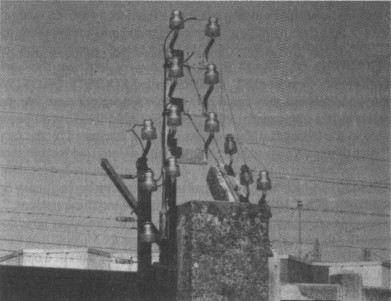
EDF substation in Compiegne with CD 535's
used to install security
electric fence.
With a list of these companies in hand, we were at their doors on Wednesday
morning, as advised. In each case, we showed them our books and many photos as
well, but nothing of any real value to us was available. COMPIEGNE was a lovely
city, but since we had come for quite a different purpose and it had been
thwarted, we almost felt that our time had been wasted. It was disappointing to
put so much into something and receive so little reward for those efforts.
So we
packed up and moved on, spending one night in GRIESHEIM, WEST GERMANY, as our
route took us westward across the tip of that country on our way to SWITZERLAND.
As we left FRANCE, we noticed how quickly the glass insulators disappeared from
the scene and porcelains took their places. What a contrast! Once inside the
Swiss border, we began to see bright yellow porcelain insulators on the lines.
There would usually be 1 or 2 yellow ones to 3 or more insulators of the same
style, but in different colors such as brown or white. We were to learn that the
yellow insulators were used to mark the neutral lines. We saw 4 different
U-numbers in yellow!
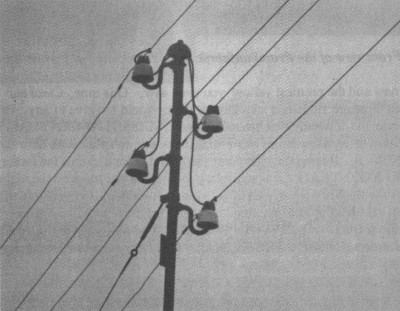
Typical Swiss pole with one yellow insulator (top left)
and three white
insulators with green tops.
Our first stop in SWITZERLAND was ZURICH, where we went to the head office of
ELEKTRIZITATSWERK DER STADT ZURICH (EWZ), or Electric Company of the City of
Zurich. My husband and I had gone to EWZ in 1983 in search of a yellow porcelain
insulator and had been given a U-1737, brand new and the prettiest yellow you ever saw. This time, Carol and I were
told that these are no longer available and they could not give us any. But they
did phone the company that produced them, SUISSE LANGENTHAL, in the city of that
name a few miles away and I was able to speak with their director, MR. STAUB. He
invited us to come the next day for a tour of the factory. So off to LANGENTHAL
it was, to find a good B&B place to spend the night. We were excited! When
we arrived to keep our appointment, we were told that MR. STAUB was held up in a
meeting and could not meet with us. Instead, he had asked his secretary, MARY
ANN WAELTI, to be our guide and give us some brochures on SUISSE LANGENTHAL.
Following is a brief summary of the company's history.
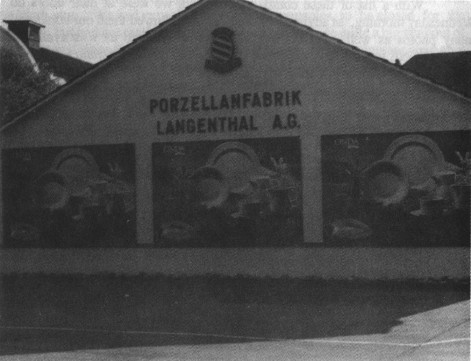
Front view of the Prozellanfabrik Langenthal A.G. at Langenthal
LANGENTHAL SUISSE CHINA
WORKS LTD. was founded in 1906. Within months, the company was able to produce
superior china for hotels and restaurants and later began to make household
china as well. Electrotechnical porcelain became one of its product lines in
1920. Since 1988, LANGENTHAL has been a subsidiary of the KERAMIK HOLDING AG
LAUFEN, which operates internationally. Several variations of the LANGENTHAL trademark were used on insulators during the years before the merger with LAUFEN.
These are shown on the following page. You'll notice the current trademark in
the accompanying photo.

Today, LANGENTHAL produces only very large insulators such as bushings, solid
core post insulators, etc. All pintypes have been discontinued and are no longer
available as replacements for those on existing lines. This was a mystery to us
because so many are still in use. Sadly, we came away without any yellow
insulators. So if you have one in your collection, consider yourself lucky. MR.
STAUB said he could not even get any for his grandchildren to play with!
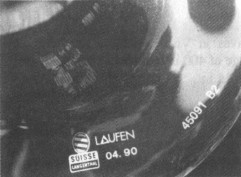
Large brown post insulator with current
LANGENTHAL / LAUFEN trademark
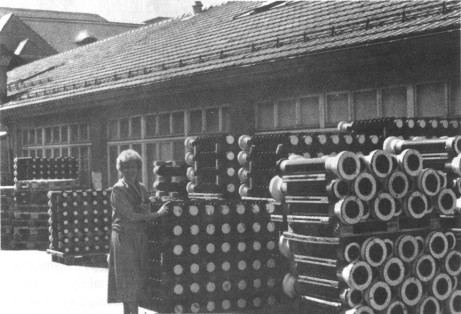
Marilyn standing by post insulators ready for shipment at Langenthal plant
MARY ANN and another employee, MR. PFAEFFLI, showed us through the buildings
where LANGENTHAL'S insulator production takes place, all the way from a lump of
clay (called "green-ware") to the finished product. For security
reasons, no pictures could he taken, so we have only those in our heads! But we
certainly treasured that experience.
Just before leaving, MARY ANN took us
through the showroom where all of LANGENTHAL's many china patterns are on
display. As a last kind gesture, the lady in charge of the showroom gave Carol
and I each a couple of small pin trays decorated with rhododendrons and stamped with
the SUISSE LANGENTHAL trademark.
Back on the road again, we journeyed
toward the small village of VUIS-TERNANZ-EN-OGOZ, near Fribourg, where we'd been
invited to spend the weekend at the home of COLLETE and REMY VOLLENWEIDER.
Collete is the mother of JEAN-PHILIPPE "J.P" DUBEY, who was an AFS
exchange student in 1984-1985, lived with the McDougalds and attended high
school with their two sons, David and Bob. Collette's daughter, MARIE- STEPHANIE
"M.S." DUBEY, also lives in Vuistemanz-en-Ogoz in the family's beautiful
farmhouse in this village of 400 inhabitants.
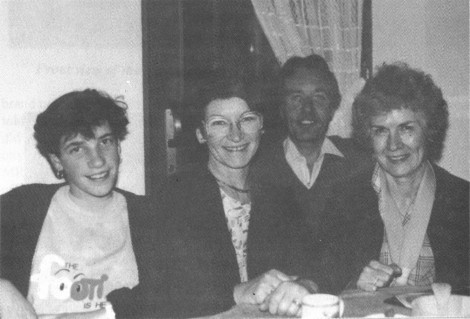
Marie-Stephanie, Collette, Remy and Marilyn
CAROL and JOHN refer to J.P. as their "son" because he became one
of the family during the year he lived with them. His face was certainly
wreathed in smiles when we arrived! The whole family is just beautiful and they
all went to great lengths to make us feel welcome during the two days we were
there. One of the highlights was a driving tour of the surrounding countryside
with its many small towns. We stopped in GRUYERE and went through their famous cheese
factory and climbed the hill to the GRUYERE CASTLE. We drove around beautiful
LAKE GENEVA, marveled at the many hillsides covered with terrace after terrace
of vineyards, and we even saw the Swiss NESTLÉ'S CHOCOLATE factory! Collete and
Remy are both culinary artists and its goes without saying that we enjoyed
several marvelous Swiss dishes. REMY makes a mean cup of coffee, too, and it was
voted the best of the entire trip.
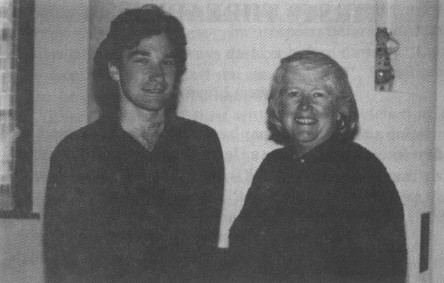
"J.P."and his "mom" Carol
MARTINE RUEGER, a friend of J.P.'s, who had
spent two weeks with the McDougalds during 1989, brought over several white
porcelain insulators with Swiss and German markings. A friend of Martine's works
for the utility company and had saved them for our visit. Both Carol and I chose
a few to bring home, so that was a treat too.
On Sunday morning, with our car
packed to the ceiling, we thanked our wonderful hosts, said goodbye and began
the long drive southward to BARCELONA, where we would catch a plane to the
Spanish island of MAJORCA. We will conclude this series of our European
adventures next time with Part V. You'll enjoy that one!
| 